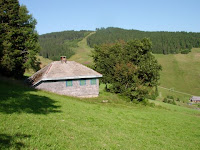space is never something that faces man. It is neither an external object nor an internal experience … I am never here only, as this encapsulated body; rather I am there, that is, I already pervade the space of the room, and only thus can I go through it.[1]
Our being is thus not isolated to a simple point in space and time but incorporates what is around us. As through verbal communication we make meaning between us, there is a similar sort of rapport that we engage in with the things around us.
Heidegger himself chose purposefully a place in which to conduct his writing, a small cabin set into the slope of a valley in the Black Forest. He chose the site and built the cabin as a place both for his family to retreat to and for him to work. Heidegger felt a close connection to the mountains that surrounded his chosen place of dwelling, as if he drew from their strength. As Adam Sharr has written, Heidegger
located himself as a susceptible scribe, suggesting that philosophy suspended the landscape in words through him almost without agency. The philosopher claimed a poignant sustenance in the changing climate of the locality, the building’s sense of interiority, the distant view of the Alps, and the spring alongside. He attributed a ‘hidden law’ to the philosophy of the mountains.[2]
The mountains, the valley, the cabin, were seen by Heidegger as dialogue partners as he confronted the important questions of Being that his work centred around. As Sharr later suggests in his book, “the mountains’ tangible presence and seasonal movements prompted explorations of existence … For him, the very ‘nearness’ of the mountain situation preceded interpretation. The material he needed to philosophize was already then laid out before him.”[3]
In order to conduct his philosophical work, this is where he chose to situate himself, and he chose to situate himself in a particular way, the cabin removed from the town below, literally set into the earth. Within, the dwelling of the house is clearly articulated as a series of compartments: a sleeping room, a kitchen, a living and dining room, and a study. Given the importance of Heidegger’s work in his life, the study is of particular interest. The writing desk sits before a window, facing east. Since he preferred to work in the morning his writing space would have been flooded with light at the time when he was at the desk. Out over the desk, through the window, the view extends along the valley towards the mountains in the distance. To the right of the desk was a table for laying things out, to the left a shelf where he would store his manuscripts. There was no bookshelf there, as he seemed to prefer to leave his books at home in the city.[4]
Heidegger felt that architecture should grow out of dwelling as a natural extension, that only in this way would it frame true dwelling in an appropriate way. But architecture is built purposefully and it is generally built quickly, not, as one is sometimes temped to think Heidegger imagines, as a snowball builds, small abberations in the internal kernal becoming exaggerated as the snow accumulates. Heidegger built the cabin in the Black Forest as the appropriate frame for his dwelling and for his encounter with the world. For this reason his cabin is of great interest to those of us interested in the relationship between building and dwelling and the meaning it bears.
[1] Heidegger, Basic Writings, 358-9.
[2] Sharr, Heidegger’s Hut, 17.
[3] Sharr, Heidegger’s Hut, 76.
[4] Sharr, Heidegger’s Hut, 34.
http://pegasus.cc.ucf.edu/%7Ejanzb/place/philosophy.htm
http://flickr.com/photos/26612130@N04/2495120356/
http://commons.wikimedia.org/wiki/File:Heideggerrundweg0013.JPG




No comments:
Post a Comment